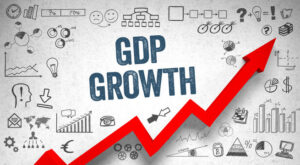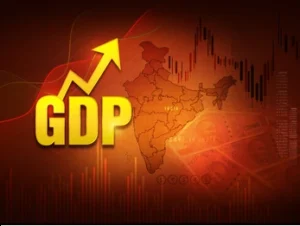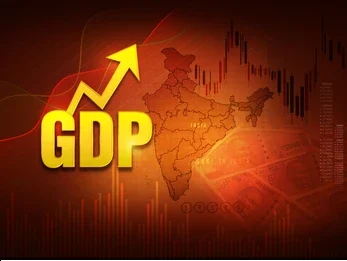“Explore the dynamic realm of Gross Domestic Product (GDP) in this comprehensive blog, unraveling its intricacies and profound impact on global economies. From dissecting the three pillars of GDP to examining its role in economic growth, competitiveness, and health, embark on a journey through the past, present, and future of this economic powerhouse. Discover the challenges and criticisms facing GDP, its relevance in the digital age, and the quest for alternative metrics. Join us in deciphering the economic heartbeat of nations and envisioning a future where prosperity transcends traditional boundaries.”
Introduction:
In the intricate web of economic indicators, one metric stands tall, commanding attention and wielding significant influence – Gross Domestic Product (GDP). This economic powerhouse serves as the compass guiding nations through the tumultuous seas of fiscal policy, providing insights into the health and vibrancy of their economies. In this exploration, we will delve into the intricacies of GDP, unraveling its mysteries and understanding the profound impact it has on the global economic landscape.
Understanding the Basics:
Before we embark on our journey into the depths of GDP, it is imperative to grasp the fundamentals. GDP, in its essence, is the monetary value of all finished goods and services produced within a country’s borders in a specific time frame. This comprehensive measure encapsulates the entire spectrum of economic activities, ranging from manufacturing and services to agriculture.

The Three Pillars of GDP:
To comprehend the true magnitude of GDP, one must dissect its three integral components – consumption, investment, and government spending. These pillars collectively define the economic vitality of a nation.
1. Consumption:
At the heart of GDP lies the consumption expenditure, reflecting the total spending by households on goods and services. This facet illuminates the purchasing power of the population, providing invaluable insights into their economic well-being.
2. Investment:
The second pillar, investment, elucidates the capital expenditure made by businesses and governments. This includes investments in machinery, infrastructure, and research and development, serving as a barometer for the nation’s economic prospects.
3. Government Spending:
The third component encompasses government spending, illustrating the financial outlay by public entities on goods and services. This sector plays a pivotal role in stabilizing and stimulating the economy through fiscal policies.
The GDP Equation:
GDP is not a mystical concept but a quantifiable metric expressed through a straightforward equation:
\[ GDP = C + I + G + (X – M) \]
Where:
– \( C \) represents consumption
– \( I \) denotes investment
– \( G \) signifies government spending
– \( X \) stands for exports
– \( M \) corresponds to imports
This equation encapsulates the intricate interplay between these components, weaving a tapestry that mirrors the economic heartbeat of a nation.
GDP and Economic Growth:
One of the most captivating aspects of GDP is its role as a barometer of economic growth. As nations aspire to climb the ladder of prosperity, a robust and consistently growing GDP becomes the beacon guiding their trajectory. However, the pursuit of economic growth is not devoid of challenges, and GDP provides a nuanced perspective on the dynamics at play.

1. Sustainable Growth:
Sustainability emerges as a critical consideration in the pursuit of economic growth. While a surge in GDP may seem alluring, ensuring that this growth is sustainable over the long term is paramount. Balancing economic expansion with environmental conservation and social well-being becomes an intricate dance that policymakers must master.
2. Inclusive Growth:
GDP, while reflective of overall economic activity, often falls short in capturing the nuances of income distribution. In the pursuit of inclusive growth, attention must be directed towards narrowing wealth gaps and ensuring that the benefits of economic prosperity reach all strata of society.
GDP and Global Competitiveness:
In the interconnected tapestry of the global economy, nations find themselves engaged in an unspoken competition for economic supremacy. GDP emerges as a key player in this arena, shaping a nation’s standing on the global stage.
1. Economic Indicators:
GDP serves as a comprehensive economic indicator, enabling nations to benchmark their performance against global counterparts. The quest for a higher GDP becomes synonymous with a desire for international recognition and influence.
2. Trade and Foreign Relations:
The economic prowess reflected in GDP directly influences a nation’s standing in international trade and diplomatic relations. Strong GDP figures bolster a country’s negotiating power, fostering an environment conducive to favorable trade agreements and alliances.

GDP and Economic Health:
Beyond the realm of growth and competition, GDP serves as a diagnostic tool, offering insights into the overall health of an economy. Examining the nuances of this metric allows economists and policymakers to identify areas of strength and vulnerability.
1. Recession and Recovery:
GDP plays a pivotal role in identifying economic downturns, commonly known as recessions. A contraction in GDP for two consecutive quarters is indicative of a recession, prompting policymakers to implement measures to stimulate recovery.
2. Employment and Unemployment:
The health of a nation’s job market is intricately tied to its GDP. A robust GDP often correlates with low unemployment rates, signifying a thriving labor market. Conversely, a stagnant or shrinking GDP may herald a rise in unemployment, necessitating targeted interventions.
GDP Challenges and Criticisms:
As with any powerful tool, GDP is not without its critics. The metric has faced scrutiny for its limitations and the inability to capture the entirety of economic well-being.
1. Quality of Life vs. GDP:
Critics argue that GDP falls short in providing a holistic view of a nation’s well-being. The metric, focused on the quantitative aspect of economic activity, overlooks qualitative aspects such as the quality of life, environmental sustainability, and overall happiness.
2. Informal Economy:
GDP struggles to accurately account for the informal economy, characterized by activities that evade official documentation and regulation. This shadow economy, often significant in developing nations, remains largely unquantified, casting a shadow over the accuracy of GDP figures.

GDP in the Digital Age:
The advent of the digital era has brought about a paradigm shift in economic activities, challenging traditional notions of production and consumption. As intangible assets and online transactions gain prominence, GDP grapples with the task of accurately capturing the new face of economic dynamism.
1. Digital Innovation and GDP:
The digital economy, fueled by technological innovation, presents both opportunities and challenges for GDP measurement. The rise of intangible assets, such as intellectual property and digital services, poses a challenge to traditional GDP accounting methods.
2. E-commerce and Globalization:
The surge in e-commerce and globalization has redefined the landscape of economic transactions. Cross-border trade, facilitated by digital platforms, introduces complexities in accurately attributing the value of goods and services to specific nations, further complicating GDP calculations.
The Future of GDP:
As we stand at the crossroads of economic evolution, the future of GDP beckons innovation and adaptation. Economists and policymakers grapple with the task of refining this metric to align with the nuances of a rapidly changing global landscape.
1. Beyond GDP: Introducing Alternative Metrics:
The limitations of GDP have spurred the exploration of alternative metrics that provide a more comprehensive understanding of societal well-being. Measures such as the Genuine Progress Indicator (GPI) and the Human Development Index (HDI) incorporate qualitative aspects, shedding light on the multifaceted nature of prosperity.
2. Environmental and Social Metrics:
The imperative to address environmental sustainability and social equity has prompted the integration of these considerations into economic metrics. The emergence of metrics that account for environmental impact and social inclusivity reflects a paradigm shift towards a more holistic evaluation of economic success.
Conclusion:
In the grand tapestry of economic indicators, Gross Domestic Product stands as a towering colossus, shaping the destiny of nations and influencing global dynamics. Its journey from a simple mathematical equation to a multifaceted measure of economic health mirrors the evolution of our understanding of prosperity.
As we navigate the complex terrain of the 21st century, the challenge lies in refining and redefining GDP to encapsulate the true essence of economic well-being.
Disclaimer:
The information provided in this blog is for educational and informational purposes only. While efforts have been made to ensure the accuracy and completeness of the content, it should not be considered as professional financial, economic, or legal advice. Readers are advised to conduct further research and consult with relevant experts or authorities before making any decisions based on the information presented in this blog. The author and publisher disclaim any liability for any loss or damage caused by reliance on the information provided herein. Additionally, the views and opinions expressed in this blog are those of the author and do not necessarily reflect the official policy or position of any organization or entity. The content is subject to change and update without notice.




